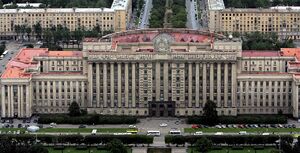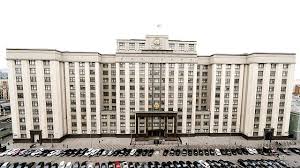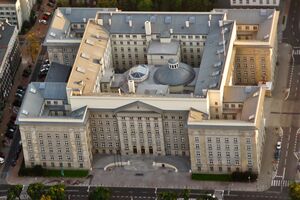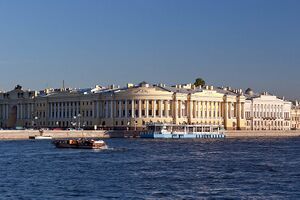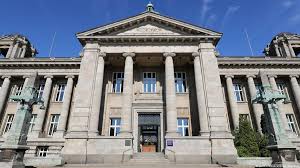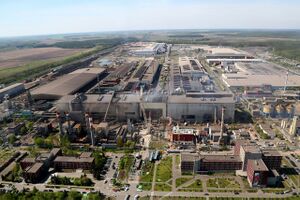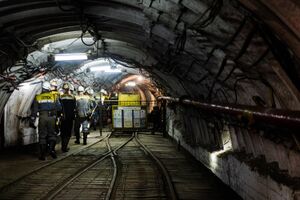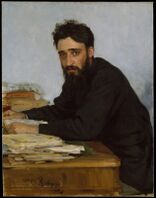Garindina: Difference between revisions
No edit summary |
mNo edit summary |
||
| Line 31: | Line 31: | ||
|demonym = Garindinan | |demonym = Garindinan | ||
|government_type = {{wp|Constitutional monarchy|Semi-Constitutional}} {{wp|Federal Monarchy}} | |government_type = {{wp|Constitutional monarchy|Semi-Constitutional}} {{wp|Federal Monarchy}} | ||
|leader_title1 = | |leader_title1 = Kezarina | ||
|leader_name1 = [[Nadia V]] | |leader_name1 = [[Nadia V]] | ||
|leader_title2 = Prime Minister | |leader_title2 = Prime Minister | ||
Revision as of 16:35, 6 November 2024
Garindinan Imperial Federation Гариндинанская Имперская Федерация Garindinanskaya Imperskaya Federatsiya | |
|---|---|
| Motto: Монархия, Федерация, Прогресс Monarkhiya, Federatsiya, Progress (Monarchy, Federation, Progress) | |
| Anthem: National Anthem of Garindina | |
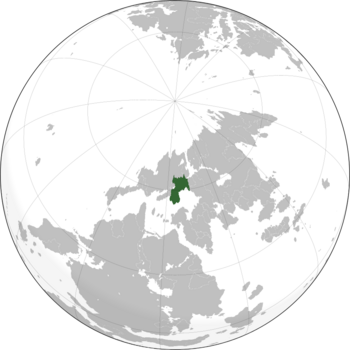 Garindina in Argis | |
| Capital | Parsa |
| Largest city | Jasanasburg |
| Official languages | Garindinan |
| Recognised national languages | Garinindan, Yuzhstovan, Doro |
| Recognised regional languages | Rusic, Korelian |
| Ethnic groups | 49% Garindinan 32% Yuzhstovan 10% Korelian 3% Other 2% Doro 2% Rusic 2% Lakoudiskfolkæ |
| Religion | Garindinan Orthodox Chirstianity |
| Demonym(s) | Garindinan |
| Government | Semi-Constitutional Federal Monarchy |
• Kezarina | Nadia V |
• Prime Minister | Evgeny Lazarev |
• Head Councilwoman | Natasha Ivanova |
• Chairman of the State Duma | Ivan Kovalenko |
| Legislature | Federal Assembly |
| State Duma | |
| Federal Council | |
| Independent State | |
• The Garindinan Empire | December 20, 1350 - July 17, 1871 |
• The Constitution War | March 23, 1869 - July 17, 1871 |
• The October Coup | October 17, 1933 |
• The Garindinan Civil War | March 31, 1983 - September 2, 1996 |
| Area | |
• | 366,296 km2 (141,428 sq mi) |
| Population | |
• Estimate | 9,958,401 |
• Census | 2020 |
• Density | 27.77/km2 (71.9/sq mi) |
| GDP (nominal) | estimate |
• Total | 186,222,098,700 |
• Per capita | 18,700 |
| Gini | 40.6 medium |
| HDI | 0.77 high |
| Currency | Grivna (Ѣ) (GRV) |
| Time zone | UTC-4, UTC-3 |
| Date format | dd-mm-yyyy (AD) |
| Driving side | right |
| Calling code | +55 |
| Internet TLD | .gr |
This article or section is in the process of an expansion or major restructuring. You are welcome to assist in its construction by editing it as well. If this article or section has not been edited in several days, please remove this template. If you are the editor who added this template and you are actively editing, please be sure to replace this template with {{in use}} during the active editing session. Click on the link for template parameters to use.
This article was last edited by Definitely not a tree (talk | contribs) 3 months ago. (Update timer) |
Garindina, formally The Garindinan Imperial Federation (Garindinan: Гариндинанская Имперская Федерация, Garindinanskaya Imperskaya Federatsiya), is a developed nation in western Argis. The country borders the Prymontian Rus to the North-East, North Dniester and Ahrana to the east, and Doria to the west. Garindina also has a boarder with Esonice via the treaty port of Yedo. Garindina has a coast with three bodies of water, these being the Canamo Sea, the Mediargic Sea, and the Sakspati Sea.
Garindina is classified as a Semi-Constitutional Federal Monarchy. The political capital is Parsa and its largest city is Jasanasburg. The first civilization can be traced back to the Paras Gari in the 1st century BC. The head of state is Nadia V from the House of Yakolev-Shishkov. The Garindinan Civil War (1983-1997) has left clear scars on the people of Garindina and the nation, with a change of government and the return of the Garindinan Monarchy.
Today, Garindina has a mixed economy with relativly low poverty rates due to the effects of the 1948 Right to Live Act. Garindina is a popular tourist destination with its many National parks and cultural activities. The nation has more than 9.95 million people who call Garindina home. Garindina is a part of the AN, Concordat, and ATARA.
Etymology
The name "Garindina" derives from ancient Yasic roots, reflecting the old pagan spiritual beliefs of the region. In the ancient pagan beliefs of Garindina, Garin is the chief god of the Kraynaduk Faith (Yasic Paganism). Garin in both the old and new beliefs, is the god of the sky, lightning, thunder, and physical realm. The land itself was seen as a manifestation of this divine power, often referred to as the "Land of Garin" in reverence to the deity's influence over the region's natural elements and the people's daily lives.
Geography
(Picture Gallery)
The geography of Garindina is quite diverse. With flat lowlands and vast grasslands in the south and rocky hills, mountains and vast forest in the north.
Climate
WIP
- Climate Map
Flora and Fauna
WIP
- picture gallery
Subdivisions
| Map | Name | Capital | Governor, or *Head of State |
|---|---|---|---|
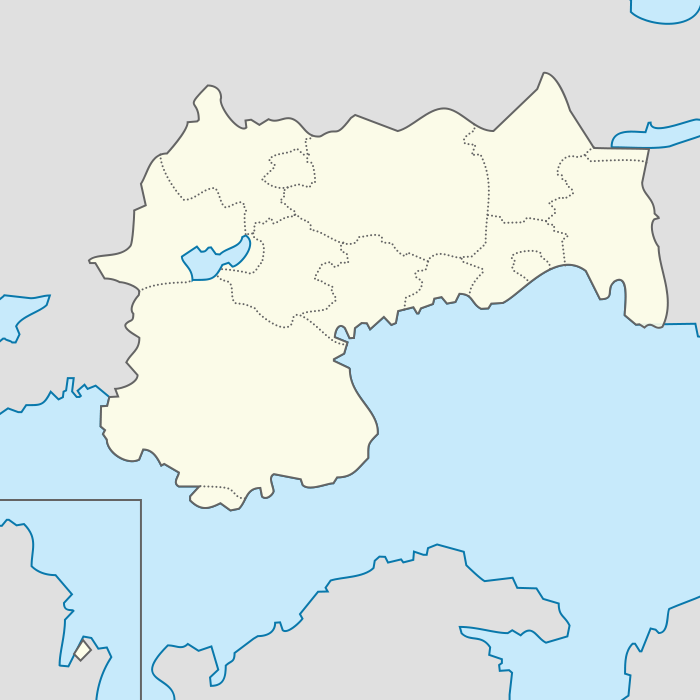
B.
J.
N.
|
Oblasts | ||
| Akmlinsk | Alma Soloveva | ||
| Visokogoriyegrad | Toma Novikov | ||
| Dovgazalsk | Koldan Kulikov | ||
| Koganelsk | Yelysaveta Dmytruk | ||
| Shishkovgrad | Yaroslav Kozlov | ||
| Rechnograd | Arina Koroleva | ||
| Zvednaya | Timur Kozlov | ||
| Vladigrad | Yustina Sokoloa | ||
| Administrative districts | |||
| Borisobay | Nataliya Guseva | ||
| Jasanasburg | Yaromir Antonov | ||
| Novokamensk | Tatyana Belova | ||
| Parsa | Kazimir Vlasov | ||
| Yuzhemore | Nazar Onyshchuk | ||
| Territory | |||
| Yedo | Prime Minister Henzo Vukunaga | ||
| Republics | |||
| Byalŭk | Nikolai Georgiev | ||
| Fermivka | Leader* | ||
History
WIP
- The Garindinan Civil War (1983-1998) left clear scars on the people of Garindina and the nation. Its outcome was a change of government and the return of the Garindinan Monarchy.
- Today, Garindina has a mixed economy, with low poverty rates, thanks to the protections enacted by the 1948 Right to Live Act.
- 2000: The Yuzhstovan Bombing happens in Garindina
- 2002: The Borislav Uprising happens in Garindina (29/10 - 27/11)
- 2003: The 2003 Uprising happens in Garindina (03/02 - 17/05)
Early History (500 BCE-100 CE)
First Princedoms (500 BCE-148 BCE)
wip
Unification of the Princedoms (148 BCE-115 BCE)
wip
Pre-Zmeyvar Period (115 BCE-100 CE)
wip
Zmeyvar Era (100CE-1137CE)
wip
Time of Troubles (1138-1279)
WIP
Age of Expansion (1280-1426)
Wip
Early Empire (1427-1614)
wip
Colonisation (1615-1859)
WIP
Modern Era (1860-1937)
wip
Bachvarov Era (1938-1964)
wip
Pre-Civil War (1965-1982)
wip
Civil War (1983-1997)
wip
Transitional Period (1998-2005)
wip
Politics
Government
The governance structure in Garindina is intricate and, at times, confusing. Classified as an Anocratic State, Garindina's government restricts national-level elections, permitting only local-level electoral processes. Operating as a Semi-Constitutional Federal Monarchy and a one-party state led by the National Royalist Party (NRP). The NRP serves as the sole political party within the nation. The power in the country is centralized within three levels of government: the monarchy, the central government (consisting of the Federal Council, the State Duma, and the Council of Ministers), and the Supreme Court.
At the top, the monarchy holds ultimate authority, with decisions made by the Crown enacted by the Council of Ministers to bring about changes. The central government, which includes the Federal Council, governs the Oblasts and Administrative Districts (ADs) of Garindina. However, all discussions and decisions within the central government require approval from the Crown. The State Duma, as the legislative body, has the unique power to challenge the Crown. It can set limits on the monarch's authority, acting as a check and balance. The local government, appointed by the Federal Council, operates autonomously without requiring the Crown's approval. Lastly, the Supreme Court serves as the enforcer of all laws enacted by the monarchy and protects the Garindinan Constitution, also known as the Nationalist Constitution.
Monarchy
The Monarchy of Garindina dates back to the first civilizations of the Gari people. Garindina is run by a hereditary monarchy and its current monarch is Czarina Nadia V. The monarchy can be split into two sections, the Old Monarchy and the New Monarchy. This split is defined by the abolishment of the monarchy after the October Coup, currently Garindina is ruled by the new monarchy. The New Monarchy has ruled Garindina since 1998, after the end of the Garindinan Civil War. The first “New Monarch” was Czar Aleksandr Yakolev, and he reigned until his death on 17 July 2015.
The Monarchs are Commander-in-Chief of the Garindinan Armed Forces and hold the authority to declare war and make alliances. Meaning that the entirety of the Garindinan Armed Forces and the Royal Guard are under the command of the Monarch. The Monarchy determines foreign policy and must sign all Acts, Bills and Laws for them to be enacted upon. Monarchs have the power to appoint Oblast and AD governors and the members of the Council of Ministers. The Monarch can also appoint the members of the Supreme Court, giving the Monarch absolute power over the Garindinan legal system. Not only that, but the Monarch also has direct control over the territories of Garindina.
Central Government
The Central Government of Garindina comprises two departments, the Federal Council and the State Duma. These two departments make up the central body of the Garindinan government. These two counsels meet six times a year at the Federal Assembly and discuss goals for the year. wip
Federal Council
The Federal Council governs the Oblast and Administrative Districts of Garindina. The Federal Council is made up of the Governors of Each Oblast and Administrative District, the current Head Councilwomen is Natasha Ivanova. Oblasts have the most autonomy in the Government, meaning they have the most power in the Federal Council. Administrative Districts have less autonomy, meaning they hold less power in the Federal Council.
Oblast were first introduced to Garindina after the Constitution War; this is due to the people of Garindina wanting representation in the government. Each of the eight Oblast and two republics has its own form of government, all being a Federal Republic with their own State Duma. Despite this, the Oblast have no say in who will be the governor, as the monarch hand-picks all governors.
The same goes for Administrative Districts, they have their own State Council but have no say over who governs them. Administrative Districts are Politically important cities. With the Constitution only stating the six Administrative Districts of Parsa, Jasanasburg, Krasbograd, Novokamensk, Borisobay, and Yuzhemore. These Districts aren't just confined to a single city either, an Administrative District consists of the city in question and some surrounding area, with Novokamensk being the largest District.
State Duma
Unlike other elements of government, the State Duma has the unique power to counter the monarchy. The State Duma is composed of a ninety-person council and is headed by Chairman Ivan Kovalenko. WIP (how does it work? what powers does it have?)
Council of Ministers
The Council of Ministers comprises the eight different ministries and is headed by Prime Minister Gregory Brezhnev. With each minister being hand-picked by the monarch as well as the prime minister, who is in control of the council. Each minister controls their own sector of administration and all decisions made by the Federal Council and the monarchy are put into effect by their respective ministry. Ministers have the power to create their own policies, but these policies must be approved by the monarch to be put into effect. But in the occasion of a policies being denied, they can edit it and send it through the federal assembly and have it approved. Despite this, the monarch can still veto the policy if seen necessary.
The Prime Minister is the head of the Council of Ministers and also represents the Council in the Federal Assembly. wip (What powers does the PM have?)
Ministries
| Name | Garindinan Name | Minister |
|---|---|---|
| Ministry of Agriculture | Министерство сельского хозяйства | Aleksandr Minsky |
| Ministry of Defence | Министерство обороны | Gedeon Molotov |
| Ministry of Education | Министерство образования | Sveta Zakharova |
| Ministry of Energy | Министерство энергетики | Mikhail Korolev |
| Ministry of Foreign Affairs | Министерство иностранных дел | Tatyana Kuzmina |
| Ministry of Health | Министерство здравоохранения | Klara Koganelskova |
| Ministry of Internal Affairs | Министерство внутренних дел | Konstantin Aleksandrov |
| Ministry of Justice | Министерство юстиции | Svitlana Hrytsenko |
| Ministry of Transportation | Министерство транспорта | Dimitri Kuzan |
| Ministry of the Economy | Министерство экономики | Fedor Tarasov |
| Ministry of the Environment | Министерство окружающей среды | Vsevolod Shcherbakov |
Judicial
Supreme Court
The Supreme Court of the Garindinan United Federation is the supreme judicial body in civil, criminal and administrative cases, in cases regarding the resolution of economic disputes and other cases falling under the jurisdiction of courts. Established in the Garindinan United Federation in accordance with Federal Constitutional Law “On the Judicial System of the Garindinan United Federation”. The Garindinan Supreme Court ultimately protects the Garindinan Constitution and the rights of the people of Garindina.
The Court holds ultimate authority over the enactment of laws and amendments to the Constitution. It is presided over by a five-judge panel appointed by the monarch. Unlike other branches of government, Judges serve a fixed twenty-year term, which may be renewed once. Members of the Court are required to maintain political neutrality and impartiality throughout their tenure.
Military Court
The Military Court is strictly for those who are in the Military, no civilian may be trialled in this Court. The Court is headed by the respected Commanding Officer of that Branch, with Two Law Degreed Military Judges. The verdict of this Court is final and cannot be overturned unless deemed a violation of Constitutional Right of the Person.
Military
The Armed Forces of Garindina is split into four different blocks. These four blocks are the Ground Force, Air Force, Navy, and Special Forces. Garindina practices conscription and mandatory military service, this means that every citizen of Garindina has to serve a mandatory 18 month service in the Garindinan Armed Forces. The age of conscription in Garindina is 21 years of age, but the mandatory two year military service must be served between the ages of 18-21. Garindina has a current 215,000 active professional military personnel and 147,000 reserve professional military personnel.
Enforcement
Federal Police
The Federal Police of Garindina are the main law enforcement body in Garindina. Each region has their own police offices headed by their own regional director. The Federal Police Services are responsible for the safety of all citizens, as well as all Government Issued Identification to all citizens.
Corruption
The Anti-Corruption Police (AKSP) is the newest police force in Garindina tasked with countering corruption in Garindina. The AKSP is a semi-independent police force that operates under the Monarchy. The AKSP, was established on 14 May 2023, as part of the Garindinan Reformation. A series of reforms in Garindina repairing systems that were inefficient and only worsened the corruption within Garindina. WIP (how do they operate?)
Economy
The Garindinan economy is a mixed economy, with government-controlled companies being common. The top three industries in Garindina are petroleum refinement, environmental tourism, and manufacturing. The Grivna is the national currency of Garindina and is also slightly inflated, making 1 Г̷̶̷ being equal to A$2.8. The minimum wage of Garindina is only 20 Г̷̶̷/hour, with a national tax rate of 35%.
Agriculture & Fishery
Garindina's Agriculture Sector is predominately based in Yuzhstova, where the fertile land and favorable climate contribute to its crop yields. Staple crops such as wheat, potatoes, and cabbage flourish alongside a variety of melons and apples. The cultivation extends to the production of sunflower and vegetable oils, highlighting the diversity and productivity of the region’s agricultural sector. Garindina's agricultural production is limited more over to its northern latitude, leading to the use of greenhouses for some crops in the Korelisk Oblast. With the Korelisk Oblast focusing more on root vegetables like Beets, potatoes and radishes.
In addition to its crop production, Garindina boasts a substantial dairy industry, with a particular focus on the northern regions. The nation’s dairy sector is marked by large-scale farms that contribute significantly to the production of milk and dairy products. The dairy sector is characterized by a blend of goat, cow, and bison milk production, with a sizable amount going towards cheese production. Bison milk, in particular, is valued for its rich, creamy texture and higher nutritional content, making it a prized ingredient in a variety of dairy products. From bison cheese to bison yogurt and butter, these products add a unique and flavorful element to Garindina’s culinary landscape.
Garindina's fishing industry is another vital component of its agricultural sector, particularly in coastal regions and along rivers. The industry thrives on a variety of fish species, including sturgeon, carp, and trout, which are abundant in its waters. Crabbing and shrimping are also significant parts of the industry, with coastal areas harvesting Mediargic crabs and Canamo king crabs and shrimp in large quantities. The industry not only supports local economies but also contributes significantly to the nation’s food supply. Processing plants along the coast ensure that fresh and preserved fish products are available year-round. Export of high-quality fish, crab, and shrimp products has also become a significant revenue stream, showcasing Garindina's rich aquatic resources to international markets.
Energy
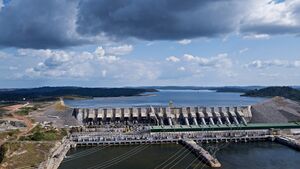
Garindina’s energy sector is heavily reliant on coal, which accounts for 41% of the country’s total energy production. Despite this fact, Garindina has been diversifying its energy production and has been expanding into more renewable sources of energy. Garindina in recent years has been expanding its hydropower and wind power capacity. This has had significant impact on Garindina’s carbon emissions lowering them significantly. Garindina’s government has planned to increase its renewable energy production by 40% by 2030.
Energy mix in Garindina.
The Krylov Dam is one of the newest hydro power plants constructed, it is owned by the Canamo Canal Company headed in Prymont. Recently, Garindina has been looking into nuclear energy. The nuclear energy program has been protested by many do to concerns of the ecological effects. As of now, 41% of Garindina's energy production is from coal power plants, with 26% from hydro, 20% from oil, 10% from wind, and 3% from solar.
Industry
Ever since the industrial revolution, Garindina has mainly had a manufacturing based economy. But as of recently, environmental tourism has grown into one of Garindina's largest industries, even passing manufacturing. The manufacturing industry is most prominent in the west of the country. Furthermore, Garindina places emphasis on sustainability and green manufacturing practices. The sector is adopting cleaner and more efficient production processes, reducing waste generation, and implementing eco-friendly initiatives to minimize environmental impact.
Overall, Garindina's manufacturing sector is a dynamic and vital part of the country's economy. It embraces technological advancements, emphasizes quality and innovation, and strives for sustainable growth, positioning Garindina as a competitive player in the global manufacturing landscape. Garindina has also been drilling and refining petrol since its discovery in the Mediargic Sea in 1967.
In recent years, petroleum refinement has become the one of the largest industries in Garindina. Garindina's oil and gas refining industry is a vital sector within the country's economy, playing a significant role in energy production and export.
The entire industry encompasses various activities involved in extracting, refining, and processing crude oil and natural gas resources. The industry also places significant emphasis on environmental sustainability and adheres to stringent regulations to minimize its ecological impact. Garindina's refineries employ advanced technologies to reduce emissions, improve energy efficiency, and implement effective waste management practices. Furthermore, the oil and gas refining industry in Garindina plays a vital role in driving economic growth and employment opportunities within the region. It attracts investments, creates jobs across various skill levels, and contributes to the overall development of the country.
Mining
Garindina’s mining industry plays a vital role in its industrial sector, being one of Garindina’s largest industries. Abundant deposits of Coal, Zinc, Copper, Iron, and Chromium contribute to its economic strength. Additionally, though less prevalent, valuable resources such as Diamond, Platinum, Manganese, and Lead are present. wip
Tourism
WIP (Pictured gallery of National Parks and Parsa, i.e. the Black Hills National Park Black Hills.)
Demographics
Ethnicity
Ethnics diversity chart (2020)
Garindina is a very ethnically diverse nation. Most of the population are considered ethnic Garindinans and Yuzhstovans with large Korelian and Doro communities. With smaller communities of Rusics and Lakkiudiskfolkæ and other smaller ethnic communities. Ethnic tensions are low and very little ethnic violance happens within the country, aside from the occasional descrimination between Garindinans and Korelians.
(REWORK NEEDED)
Religion
The freedom of religion is a guaranteed right in Garindina. Despite this, the national religion being Garindinan Orthodox. Garindinan Orthodox is the most prominent religion practiced in Garindina, with 7.3 million followers within Garindina. In recent years, a growing number of people identify as irreligious, with 1.7 million people identifying as irreligious.
(REWORK NEEDED)
Health
WIP
Culture
Garindina, having many ethnic groups is very culturally diverse. This cultural mosaic is deeply rooted in Garindina's geography and history. The diverse traditions trace their origins back to the Early Gari People, who migrated to the Paras River Valley during the Late Gari Migration. The Early Gari People that who migrated to the Paras River Valley during the Late Gari Migration in the 10th century As a result of the migration, some of these cultures mixed and are similar but still distinct from each other. This historical movement facilitated cultural exchanges, resulting in a blend of traditions that, while distinct, often share common elements.
Art
Art in Garindina is quite unique and deeply rooted in environmental beauty and cultural heritage. This is a result of Garindina's immense environmental beauty and profound reverence for its diverse ecosystems. Portraits and artworks in Garindina often reflect the natural landscapes and historical figures, blending realism with symbolic representations of the nation's identity. Artists frequently draw inspiration from the lush forests, majestic mountains, and serene lakes that characterize Garindina's geography. Portraits of monarchs, historical figures, and local heroes are often depicted with backgrounds that incorporate elements of the country's natural beauty, showcasing a deep connection between art and the environment. This artistic approach not only celebrates Garindina's rich cultural heritage but also emphasizes its commitment to preserving and honoring its natural landscapes through creative expression.
One famous artist from Garindina is Ivan Kozlov. His artistic works include portraits, various environments and cityscapes. He often depicts his home city of Rechnograd and its surrounding areas in his works. While his portraits are often of the local people of Rechnograd, capturing what life was like for the average person in the late 18th century. Kozlov’s work reflects a deep connection to his country’s cultural heritage and natural beauty. Through his art, he highlights the interplay between Garindina’s rich history and its breathtaking environment.
Cuisine
WIP
Education
WIP
Language
WIP
Literature
Along with Garindina's unique language, literature in Garindina is deeply intertwined with the nation's cultural heritage and history. The written works of Garindina often serve as repositories of its oral traditions, myths, and historical narratives. With some of Garindina's classic literary works including heroes from folklore, myth Garindina's history alike, recounting their feats and impact on life. These classic literary works vividly recount the daring feats and enduring impact of these heroes on the lives of the Garindinian people. Inspiring generations with tales of bravery, wisdom, and resilience.
One famous author and poet from Garindina is Pavel Komarov. His literary works reflect a diverse range of themes, from dark and psychological explorations to historical dramas and poignant love poetry. His upbringing, characterized by a difficult childhood, deeply influenced his writing, leading to works that delve into dark and psychological themes. Among his notable contributions is "The War of Two Czars". A book about the war of the same name and a gripping historical drama that later got a stage adaptation and eventually a film adaptation. The book captures the essence of power struggles and life during the middle ages in Garaindina. Through his literary endeavors, Pavel Komarov continues to inspire contemplation on life's complexities, leaving an indelible mark on Garindina's cultural and literary heritage.
Festivals & Holidays
Garindina has six National Holidays that are celebrated throughout the nation, with a wide verity of activities depending on the day. During Midsummer celebrations, the most prominent celebrations are carnivals and dance. Whilst on Remembrance Day, bonfires and memorials to honor the dead are held.
There are many Regional Holidays that are celebrated by their respected regions as well. These Regional Holidays are celebrated in their own ways that reflect the culture of the area, and sometimes only celebrated in that region. For example, Dyen’ Pervoknyaza, a Yuzhstovan holiday, that is only celebrated in Yuzhstova.
National Holidays:
- New year celebrations: Dec 31-Jan 1
- The Czarina's birthday: March 22
- Saint Pavel’s Day: Last Sunday of May
- Midsummer: June 23-25
- Remembrance Day: July 17
- Federation Day: September 2
Notable Regional Holidays:
- Day of the First Prince: April 17, celebrates the crowning of the First Yuzhstovan Knyaz.
- Day of Korelian Speech: July 24, celebrates Korelian Language.
- Day of our Gods: July 4, celebrates the Dorian resistance from christianization
- Saint Gleb’s Feast: June 1, Celebrates Saint Gleb for his Virtues of humility and compassion.
Sports
WIP




